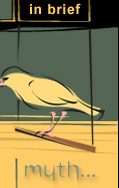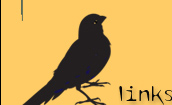TRY THIS ON FOR SIZE...
Imagine a space, let’s say your bedroom – approximately the size of four times your arm span by 6 times your arm span. How long will it be before YOU go stir crazy? Now imagine someone else controlling what goes into that space, including other people. So you’re now confined and isolated. And how often is it cleaned? What do you do? If you’re obtuse enough to consider that an animal, bird or fish is incapable of experiencing distress, then spend some time noticing the real simple stuff like the sounds a creature makes, or its body language. Does your bird make cheeping sounds? If you pay attention you can generally figure out what the problem is. Is it flying in tiny circles or flapping against the bars? Does it hop frenetically from perch to perch? Well if its cage is four to six times its wingspan how can it fly? This is elementary stuff and there’s so much information available out there that there can be no excuse for ignorance. A canary can live for 15 years. Birds should not be kept in tiny cages, such as those you will find in most pet shops.
Confining a bird to a tiny space amounts to CRUELTY. Don’t do it.
An unhappy bird will not sing well, if at all. Click here for other reasons why your bird may not be singing.
MY BIRDCAGE/AVIARY
Here is an attractive and practical indoor/outdoor aviary that I had custom built (many thanks Uncle Frank!), with removable divisions for breeding season.

CAGE SIZE AND CONTENTS
There is a current trend for decorative birdcages – most of these are completely unsuitable for canaries. Many are too small, too thin, built of toxic materials, or the bars are wider than the maximum requirement for canaries of 12mm. Here are some guidelines that will help you to ensure your pet birds are happy and healthy, despite being confined to a wire cage for the term of their natural life:
- SHAPE OF CAGE: Wider rather than higher. Round cages are not suitable as there are no corners for the birds to retreat to if necessary, and the flying space is much too restrictive.
- WIRE: Aviary wire is best (12mm x 12mm mesh) especially if you have the cage outside at any time, as it protects the canaries against certain wild birds, who, with their long beaks can kill and pull a bird right through vertical bars.
- PERCHES: Do not use sandpaper perches as these will hurt the bird’s feet. Use natural (non-toxic) branches of varying thicknesses.
- BASE LINER: Use bird sand or washed river sand in the cage base. It cuts down cleaning and is more hygienic than paper. Do not use sandpaper sheets on the base of the cage. It will damage a canary’s feet.
- SWING: Males like a canary swing.
- FOOD & WATER CONTAINERS: Keep food and water containers above perches so that they are not contaminated by droppings. Canaries like to toss their seed around so you may like to use containers with hoods, available at pet shops. Avoid automatic seed dispensers as they tend to clog with husks and the birds cannot reach the seed. Sample feeders and drinkers.
- BIRDBATH: This is an essential item. Provide a birdbath with fresh water every day as birds are happiest when they can bathe daily. An unhappy bird will not sing.
- POSITION: Do not place birdcage in a draught or in a full sun position. The birds can catch a chill or overheat – both can be fatal.
- CLEANING: Clean cage daily, and thoroughly clean it once a month. Don’t use disinfectants unless birds have been ill. For information on the effects of disinfectants and cleaners click here. Rinse thoroughly. Remove perches to scrub and soak them in hot water. Allow to dry before replacing. Clean all food and water dishes daily. If you use washed river sand in the tray, replace it weekly. Otherwise clean tray daily.
- COVER: Cover the cage at night with a cloth - not synthetic as it tends to attract static electricity - leave an opening for air to circulate. In summer leave one side open, but clear of draughts.
- FREE FLIGHT: Allow birds to fly free once a day after removing all hazards from room (bookcases, toxic plants, animals, fans, lamps and light globes, anything a bird can get trapped in or injured by). Cover windows and mirrors so the birds won’t fly into the glass. Some bird lovers build a bird tree (built out of non-toxic branches in a weighted bucket) and place it in a room where the birds can fly free. Place seed just outside cage at first, so birds can find their way back. They soon get used to it and will go back to the cage when they get hungry.
RESPONSIBILITIES OF PET OWNERS
As a pet owner it is YOUR responsibility to ensure the health and well being of all creatures in your care. The Victorian Prevention of Cruelty to Animals Act covers all animals and birds and proclaims the following offences pet owners should know about:
- Abandoning an animal, failing to provide drink, food or shelter for an animal.
- Ill-treating, injuring, tormenting or torturing an animal.
- Killing an animal in a cruel manner unlawfully or maliciously.
It’s your responsibility to ensure you provide conditions that comply with RSPCA five freedoms:
- Free from hunger and thirst.
- Free from discomfort.
- Free from pain, injury and disease.
- Free to express normal behaviour.
- Free from fear and distress.
|






